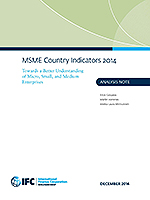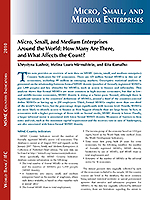This note provides an overview of the updated and expanded data for the MSME Country Inidcators database across 155 economies. Descriptive statistics for MSME definitions and data are presented. The analysis of MSME definitions suggests that the most widely used variable for defining an MSME is the number of employees followed by turnover and assets. Variability for threshold values is high among countries, but it reduces with firm size. In general, it was found that threshold values tend to decrease with country incomes. The analysis of data indicates that there are around 162.8 million formal MSMEs where more than 508 million employees work. High income economies have the highest number of MSMEs per 1,000 people while the highest growth rates are found among lower middle income economies. MSME share of employment fluctuates between 50 to 70 percent across regions.
Even though MSMEs are important in terms of number of enterprises and contribution to employment, there is room for improvement in terms of their contribution to value added, particularly in developing countries. Better access to finance, streamlined business environments, a better competitive landscape, adequate institutional frameworks, less poverty and increased shared prosperity are related to higher numbers of formal MSMEs per 1,000 people around the world. Finally, the quantity and quality of MSME data require drastic improvements in order to produce rigorous studies and enhance the understanding of the MSME sector.
More
